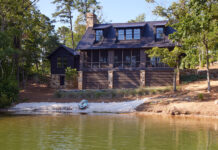A Do-it-yourself project is always bigger than it seems, and it always involves more than one surprise along the way. For David Hill and his family, the transformation of a 1920s post-industrial building in Auburn required plenty of DIY determination as well as his expertise as an architect and landscape architect.
When David accepted a teaching position at Auburn, the couple rented a house in hopes of finding a commercial site to convert. “We looked for months, ” David says. “We finally found this place on Bragg Avenue. At the time, it housed a cabinet shop, but we later found out that it has had quite a history.”

|
Uncovering bits and pieces of lore through community stories and the building’s rubble, David and his wife, Elizabeth, embarked on what would become almost a two-year project and their intrigue grew. “After we made the offer, we spent about nine months getting zoning variances, doing engineering and design studies, figuring out our budget, and pouring over inspections, ” David says. “It was only after we knew we could do it that we signed the contract.”
Once they gave themselves the go-ahead, David and Elizabeth worked with contractor Gregory “Scoop” Langston of HF&L to start the demolition, salvage, and building process. “I can’t give him enough credit for his help, ” David says. “He guided my efforts throughout the project by advising me about the things I could do myself to save money and what I should hire out.”
The brick building is essentially one big rectangle. Over the years it has housed numerous businesses. Interior spaces were sealed off and divided. David’s goal was to unite these rooms and reconfigure them into a place for his family. The walls, floors, and ceilings were removed or cleaned up, openings were closed up and recut, and new or restored pieces were put in place. In the living area, a large steel door slides to open or close the space between the TV room and the kitchen/great room. “We tried to save everything we could, ” David says. “Everytime we pulled something out of the building we’d throw it in a stockpile. We found ourselves returning to it for supplies again and again.” Slabs of concrete became walkways and stepping stones in the garden, a wooden shed became an outdoor tabletop, a gas line became a curtain rod in the master bedroom, and a shipping container found new purpose as a garden shed and wood shop.
Throughout the house and landscape, there’s a synergy that hasn’t gone unnoticed. David has won awards for the home’s architecture, landscape design, kitchen, and building. “It is nice to be recognized in all of these categories, ” David says. “A holistic approach in design is very important to me.”

ABOVE The TV room shows the Hill’s flair for mixing thrift store finds and salvage furniture. Metal ceiling tiles and moulding, original to the building, were taken down and repainted during the renovation. Light fixtures, floorlamps from IKEA, were turned upside down to illuminate the vast living area (shades were flipped). A sign culled from Elizabeth’s father’s business hangs on one wall. Above a desk, David displays a collection of photographs documenting the changing view of one landscape.
Similarly, the interior design works in cohesion with the loft-like space. Most of the furniture is thrift store, salvage, or hand-me-down. The couple is especially fond of metal furniture and filing cabinets. “They are great for storage, ” Elizabeth says. She fills them with paper, markers, scissors, and office supplies in the kids’ “study hall.” Others serve as coffee tables and end tables in the living areas.
In the kitchen, new cabinets are painted filing cabinet gray/green to tie in with the old pieces. The dining table is a painted board laid across a pair of bright yellow sawhorses. Surrounding the table is what Elizabeth calls their collection of “ten dollars and under” chairs. Vintage signs hang as artwork. The Culpepper Lumber Company sign was culled from Elizabeth’s father’s business. The “Southern Delite” sign in the kitchen was found on the property—one more piece of evidence of the building’s history and a telling forecast for this home’s future.



ABOVE The original walls were stripped of plaster to reveal the brick beneath. Demolition stopped at chair rail height to represent wainscotting. “We chose all of our paint and accent colors from the patina on the walls, ” Elizabeth says. Her favorite shade? The red glitter paint from the building’s days as the “King Congo Club.”


ABOVE The family invites friends to enjoy movie night in the garden.

ABOVE David converted a shipping container into a storage unit and workshop.

ABOVE The French doors in the master bedroom replaced an old garage door—the former opening to an automotive shop. Draperies (painter’s dropcloth) are hung from a retrofitted gas line. The fabric conceals closets and an opening to the master bathroom. The wingchair is a $40 thrift shop find.
ALONG THE WAY
The home’s history was revealed piece by piece during the demolition and reconstruction phase. “What we didn’t discover on site, we found by talking to neighbors and researching old phone books, ” Elizabeth says. Over the years, the building has housed a nightclub, grocery store, cab company, recycling center, pool hall, and church.






text by Cathy Still McGowin • photography by Jean Allsopp





